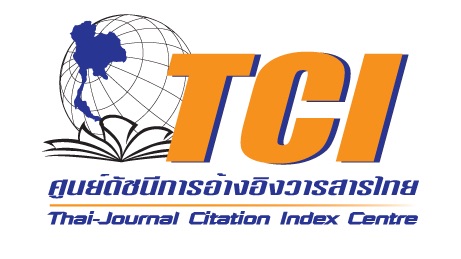The Pottery Industry and the Socio-economic Changes of Thai Phuan Ban Chiang community, Nong Han District, Udon Thani Province During 1972–2020
Keywords:
Pottery, Thai Phuan Ban Chiang community, Industry, Udon ThaniAbstract
This article aims to study examined the socio-economic changes of the Thai Phuan Ban Chiang community, Nong Han District, Udon Thani Province as a result of the expansion of the pottery manufacturing industry between 1972 and 2020. From the study, it was found that before 1972, the economic and social changes had not changed much. The economic characteristics were also subsistence, where farming was the main occupation and pottery was produced as an additional occupation after the farming season. Until 1972 - 2012, they began to have economic changes within the community due to the establishment of a vocational school, the community was raised as a sanitation district in Ban Chiang Nai Subdistrict in 1986 , and was raised as Ban Chiang Municipality in 1999, respectively. As a result of the establishment of the US military base in Udon Thani Province, the government's role in the development of Ban Chiang Archaeological Site, The travelling to Udon Thani of King Rama IX, the government policy of the 1995-1996 Banharn Silpa-archa government that promotes local commerce, and the presence of entrepreneurs. As a result, the pottery activity expanded, but it still did not have much of an impact on society. Social characteristics were also a system of kinship attached to custom. Until after 2012 to 2020, a group of scholars and researchers were involved in changing the form of pottery and receiving support from organizations both within and outside the community. From the original that was used to be used as a decorative utensil, resulting in more widespread awareness. There was the development of a unique pattern "Lila Lai" in 2019. At the same time, the presence of foreign capitalists and businessmen to invest in pottery trade and production has also contributed to the change in manufacturing activities. From the industrial production in the household to an industry that has a management system in the form of commercial enterprises, community enterprises and creative industrial villages, which has changed the economic and social conditions of the community. From the way of life that used to be free in pottery production, it had to be bound by the capitalist system and working according to the factory system. Capitalists have come to play a role in the production of pottery, forcing some villagers who used to produce pottery to turn to other professions. Some people switched to workers instead. In addition, the economic condition of the community is growing more. We will also encounter social problems as a result.
References
กนิษฐา เรืองวรรณศิลป์. (2557). ลวดลายประทับดินเผาบ้านเชียง: บูรณาการสู่การออกแบบผลิตภัณฑ์เชิงพาณิชย. วารสารศิลปกรรมศาสตร์ มหาวิทยาลัยขอนแก่น, 6(2), 1-25.
กรมศิลปากร. (2560). มรดกโลกบ้านเชียง. กรมศิลปากร.
คริส เบเคอร์ และผาสุก พงษ์ไพจิตร. (2558). ประวัติศาสตร์ไทยร่วมสมัย. มติชน.
จัดตั้งสุขาภิบาลบ้านเชียง อำเภอหนองหาน จังหวัดอุดรธานี. (2529, 18 ตุลาคม). ราชกิจจานุเบกษา. เล่ม 100 ตอนที่ 167. หน้า 187.
จัดตั้งสุขาภิบาลบ้านเชียง อำเภอหนองหาน จังหวัดอุดรธานี. (2549, 10 เมษายน). ราชกิจจานุเบกษา. เล่ม 194 ตอนที่ 42. หน้า 124.
ชวลิต การรื่นศรี. (2542). การส่งเสริมและพัฒนาการประกอบอาชีพเครื่องปั้นดินเผา[วิทยานิพนธ์ศิลปศาตรมหาบัณฑิต สาขาวิชาการพัฒนาสังคม].
มหาวิทยาลัยขอนแก่น.
เชี่ยวชาญ แสงทอง. (2556). รายงานการวิจัยฉบับสมบูรณ์: การศึกษาและพัฒนาเครื่องปั้นดินเผาบ้านโพนทราย อำเภอกันทรารมย์ จังหวัดศรีสะเกษ. มหาวิทยาลัยราชภัฏศรีสะเกษ.
ประภากร แก้ววรรณา. (2554). การจัดการความรู้ภูมิปัญญาท้องถิ่น. โรงพิมพ์มหาวิทยาลัยราชภัฏมหาสารคาม.
เปี่ยมสุข เหรียญรุ่งเรือง. (2537). เอกสารคำสอนประกอบรายวิชาประวัติเครื่องเคลือบดินเผา. วิทยาลัยครูพระนคร.
ผกามาศ ชัยรัตน์ และ ชวลีย์ ณ ถลาง. (2560). ศักยภาพทรัพยากรการท่องเที่ยวจังหวัดอุดรธานี. วารสารวิทยาลัยดุสิตธานี, 11(2), 124-141.
พยงค์ การิเทพ. (2553). การจัดการเรียนรู้เครื่องปั้นดินเผาโดยใช้กระบวนการจัดการความรู้ [วิทยานิพนธ์ครุศาสตรมหาบัณฑิต สาขาหลักสูตรและการสอน]. มหาวิทยาลัยราชภัฏมหาสารคาม.
พระวิชชญะ น้ำใจดี และ เพ็ชรัตน์ ไสยสมบัติ. (2561). การมีส่วนร่วมของชุมชนในนโยบายการจัดการแหล่งท่องเที่ยวเชิงวัฒนธรรม: กรณีศึกษาบ้านเชียง จังหวัดอุดรธานี. วารสารวิทยาลัยสงฆ์นครลำปาง, 7(2), 283-294.
ไพฑูรย์ มีกุศล. (2523). เอกสารคำสอนประวัติศาสตร์อารยธรรมอีสาน. มหาวิทยาลัยศรีนครินทรวิโรฒ.
มณแทน ตันบุญต่อ. (2545). ประวัติเครื่องปั้นดินเผาไทย. สถาบันราชภัฏมหาสารคาม.
มานะ เอี่ยมบัว. (2559). การออกแบบและพัฒนาเพื่อเพิ่มมูลค่าผลิตภัณฑ์เครื่องปั้นดินเผาในเขตภาคตะวันออกเฉียงเหนือ. วารสารวิจัยวไลยอลงกรณ์ในพระบรมราชูปถัมภ์ สาขาวิทยาศาสตร์และเทคโนโลยี, 5(2), 83-96.
โรงเรียนบ้านเชียง. สมุดหมายเหตุรายวันโรงเรียนบ้านเชียง เล่ม 3 ลงวันที่ 18 ตุลาคม พ.ศ. 2497. หน้า 97.
โรงเรียนประถมอาชีพอำเภอหนองหาน. สมุดหมายเหตุรายวันโรงเรียนประถมอาชีพอำเภอหนองหาน เล่ม 9 ลงวันที่ 10 มกราคม พ.ศ. 2521. หน้า 62.
วิลภา กาศวิเศษ. (2553). การพัฒนาลวดลายเพื่องานออกแบบจากอิทธิพลศิลปกรรมบ้านเชียง [วิทยานิพนธ์ ศิลปศาสตรมหาบัณฑิต สาขาการออกแบบนิเทศศิลป์]. มหาวิทยาลัยศิลปากร.
สพสันติ์ เพชรคำ. (2540). ปากยาม: หมู่บ้านประมงในลุ่มแม่น้ำสงครามกับการเปลี่ยนแปลงทางเศรษฐกิจและสังคม [วิทยานิพนธ์ ศิลปศาสตรมหาบัณฑิต สาขาไทยคดีศึกษา (เน้นสังคมศาสตร์)]. มหาวิทยาลัยมหาสารคาม.
สำนักงานเทศบาลตำบลบ้านเชียง. (2564). ข้อมูลชุมชนบ้านเชียง 2564. (ม.ป.พ.).
สำนักวัฒนธรรมจังหวัดอุดรธานี. (2544). วัฒนธรรม พัฒนาการทางประวัติศาสตร์เอกลักษณ์และภูมิปัญญาจังหวัดอุดรธานี. โรงพิมพ์คุรุสภา.
สุวิทย์ ธีรศาศวัต. (2551). เศรษฐกิจอีสานหลังมีทางรถไฟ (พ.ศ. 2443–2458).มหาวิทยาลัยขอนแก่น.
อังคณา แสงสว่าง. (2550). บทบาททางเศรษฐกิจของชาวจีนในจังหวัดฉะเชิงเทราระหว่าง พ.ศ. 2398–2475 [ปริญญานิพนธ์ การศึกษามหาบัณฑิตสาขาประวัติศาสตร์ไทย]. มหาวิทยาลัยศรีนครินทรวิโรฒ ประสานมิตร.
Downloads
Published
How to Cite
Issue
Section
License

This work is licensed under a Creative Commons Attribution-NonCommercial-NoDerivatives 4.0 International License.







